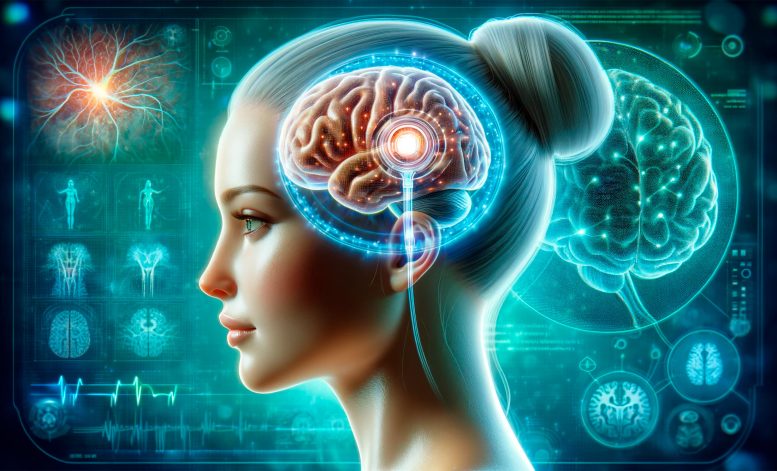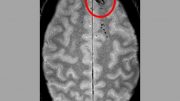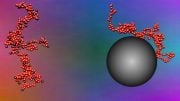
Stanford Medicine’s clinical trial using deep-brain stimulation offered new hope for those with moderate to severe brain injuries. The treatment significantly improved cognitive functions and daily life activities, showcasing a breakthrough in brain injury treatment. Credit: SciTechDaily.com
A new technique using deep brain stimulation tailored to each patient exceeded researchers’ expectations in treating the cognitive impairments from moderate to severe traumatic brain injury.
In 2001, Gina Arata was in her final semester of college, planning to apply to law school, when she suffered a traumatic brain injury in a car accident. The injury so compromised her ability to focus she struggled in a job sorting mail.
“I couldn’t remember anything,” said Arata, who lives in Modesto with her parents. “My left foot dropped, so I’d trip over things all the time. I was always in car accidents. And I had no filter — I’d get pissed off really easily.”
Her parents learned about research being conducted at Stanford Medicine and reached out; Arata was accepted as a participant. In 2018, physicians surgically implanted a device deep inside her brain, and then carefully calibrated the device’s electrical activity to stimulate the networks the injury had subdued.

After receiving a traumatic brain injury in a car accident, Gina Arata was unable to focus well enough to read. A device implanted in her brain has improved her ability to focus, her memory and her mood. Credit: Courtesy of the Arata family
She noticed the difference immediately: When she was asked to list items in the produce aisle of a grocery store, she could rattle off fruits and vegetables. Then a researcher turned the device off, and she couldn’t name any.
“Since the implant I haven’t had any speeding tickets,” Arata said. “I don’t trip anymore. I can remember how much money is in my bank account. I wasn’t able to read, but after the implant I bought a book, Where the Crawdads Sing, and loved it and remembered it. And I don’t have that quick temper.”
Breakthrough in Brain Injury Treatment
For Arata and four others, the experimental deep-brain-stimulation device restored, to different degrees, the cognitive abilities they had lost to brain injuries years before. The new technique, developed by Stanford Medicine researchers and collaborators from other institutions, is the first to show promise against the long-lasting impairments from moderate to severe traumatic brain injuries.
The results of the clinical trial were published on December 4 in the journal Nature Medicine.
Living With Traumatic Brain Injury
More than 5 million Americans live with the lasting effects of moderate to severe traumatic brain injury — difficulty focusing, remembering and making decisions. Though many recover enough to live independently, their impairments prevent them from returning to school or work and from resuming their social lives.
“In general, there’s very little in the way of treatment for these patients,” said Jaimie Henderson, MD, professor of neurosurgery and co-senior author of the study.
However, the fact that these patients had emerged from comas and recovered a fair amount of cognitive function suggested that the brain systems that support attention and arousal — the ability to stay awake, pay attention to a conversation, and focus on a task — were relatively preserved.
Understanding and Targeting the Brain
These systems connect the thalamus, a relay station deep inside the brain, to points throughout the cortex, the brain’s outer layer, which controls higher cognitive functions.
“In these patients, those pathways are largely intact, but everything has been down-regulated,” said Henderson, the John and Jene Blume-Robert and Ruth Halperin Professor. “It’s as if the lights had been dimmed and there just wasn’t enough electricity to turn them back up.”
In particular, an area of the thalamus called the central lateral nucleus acts as a hub that regulates many aspects of consciousness.
“The central lateral nucleus is optimized to drive things broadly, but its vulnerability is that if you have a multifocal injury, it tends to take a greater hit because a hit can come from almost anywhere in the brain,” said Nicholas Schiff, MD, a professor at Weill Cornell Medicine and co-senior author of the study.
The researchers hoped that precise electrical stimulation of the central lateral nucleus and its connections could reactivate these pathways, turning the lights back up.
Clinical Trial Success
In the trial, the researchers recruited five participants who had lasting cognitive impairments more than two years after moderate to severe traumatic brain injury. They were aged 22 to 60, with injuries sustained three to 18 years earlier.
The challenge was placing the stimulation device in exactly the right area, which varied from person to person. Each brain is shaped differently to begin with, and the injuries had led to further modifications.
“That’s why we developed a number of tools to better define what that area was,” Henderson said. The researchers created a virtual model of each brain that allowed them to pinpoint the location and level of stimulation that would activate the central lateral nucleus.
Guided by these models, Henderson surgically implanted the devices in the five participants.
“It’s important to target the area precisely,” he said. “If you’re even a few millimeters off target, you’re outside the effective zone.”
A Pioneering Moment
After a two-week titration phase to optimize the stimulation, the participants spent 90 days with the device turned on for 12 hours a day.
Their progress was measured by a standard test of mental processing speed, called the trail-making test, which involves drawing lines connecting a jumble of letters and numbers.
“It’s a very sensitive test of exactly the things that we’re looking at: the ability to focus, concentrate, and plan, and to do this in a way that is sensitive to time,” Henderson said.
At the end of the 90-day treatment period, the participants had improved their speeds on the test, on average, by 32%, far exceeding the 10% the researchers had aimed for.
“The only surprising thing is it worked the way we predicted it would, which is not always a given,” Henderson said.
Impact on Participants’ Lives
For the participants and their families, the improvements were apparent in their daily lives. They resumed activities that had seemed impossible — reading books, watching TV shows, playing video games or finishing a homework assignment. They felt less fatigued and could get through the day without napping.
The therapy was so effective the researchers had trouble completing the last part of their study. They had planned a blinded withdrawal phase, in which half the participants would be randomly selected to have their devices turned off. Two of the patients declined, unwilling to take that chance. Of the three who participated in the withdrawal phase, one was randomized to have their device turned off. After three weeks without stimulation, that participant performed 34% slower on the trail-making test.
Advancing Brain Injury Treatment
The clinical trial is the first to target this region of the brain in patients with moderate to severe traumatic brain injury, and it offers hope for many who have plateaued in their recovery.
“This is a pioneering moment,” Schiff said. “Our goal now is to try to take the systematic steps to make this a therapy. This is enough of a signal for us to make every effort.”
Reference: “Thalamic deep brain stimulation in traumatic brain injury: a phase 1, randomized feasibility study” by Nicholas D. Schiff, Joseph T. Giacino, Christopher R. Butson, Eun Young Choi, Jonathan L. Baker, Kyle P. O’Sullivan, Andrew P. Janson, Michael Bergin, Helen M. Bronte-Stewart, Jason Chua, Laurel DeGeorge, Sureyya Dikmen, Adam Fogarty, Linda M. Gerber, Mark Krel, Jose Maldonado, Matthew Radovan, Sudhin A. Shah, Jason Su, Nancy Temkin, Thomas Tourdias, Jonathan D. Victor, Abigail Waters, Stephanie A. Kolakowsky-Hayner, Joseph J. Fins, Andre G. Machado, Brian K. Rutt and Jaimie M. Henderson, 4 December 2023, Nature Medicine.
DOI: 10.1038/s41591-023-02638-4
Researchers from Weill Cornell Medicine, Spaulding Rehabilitation Hospital in Boston, Harvard Medical School, the University of Utah, the University of Florida, Vanderbilt University, the University of Washington, the University of Bordeaux, and the Cleveland Clinic also contributed to the study.
The study was supported by funding from the National Institute of Health BRAIN Initiative and a grant from the Translational Science Center at Weill Cornell Medical College. Surgical implants were provided by Medtronic.










Be the first to comment on "Reviving Minds: Implant Restores Cognitive Functions After Brain Injury"